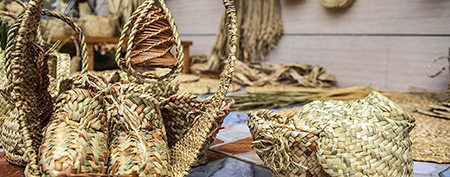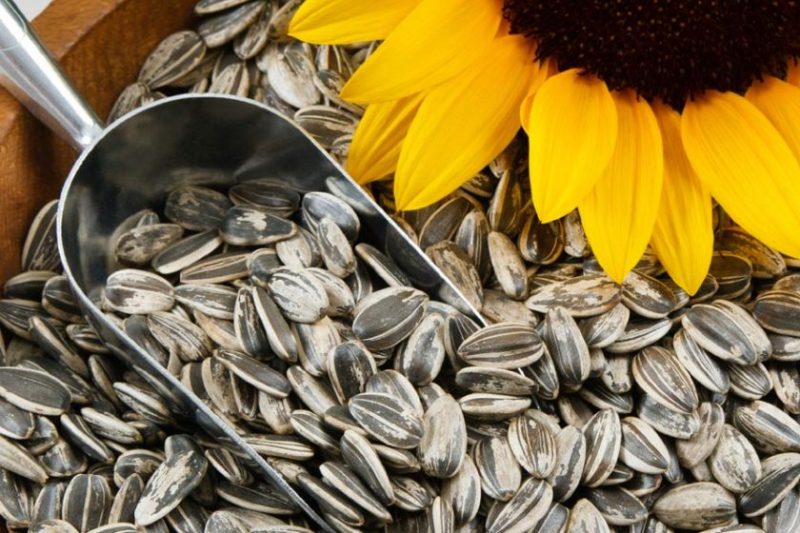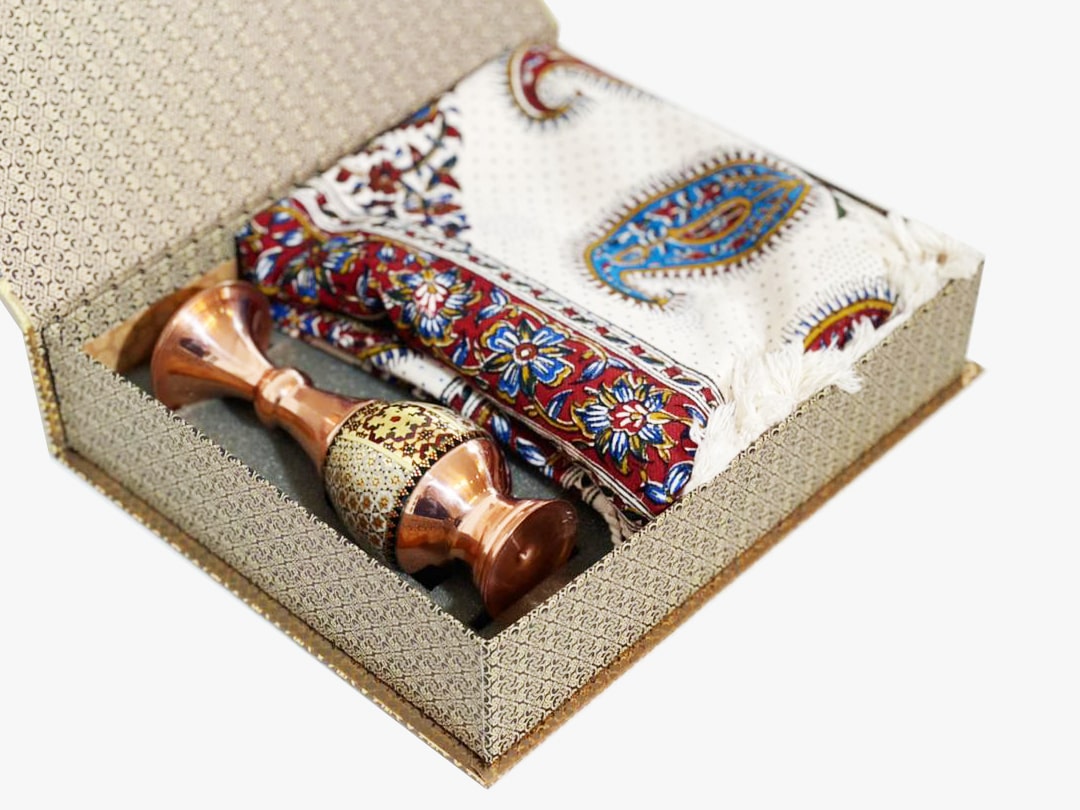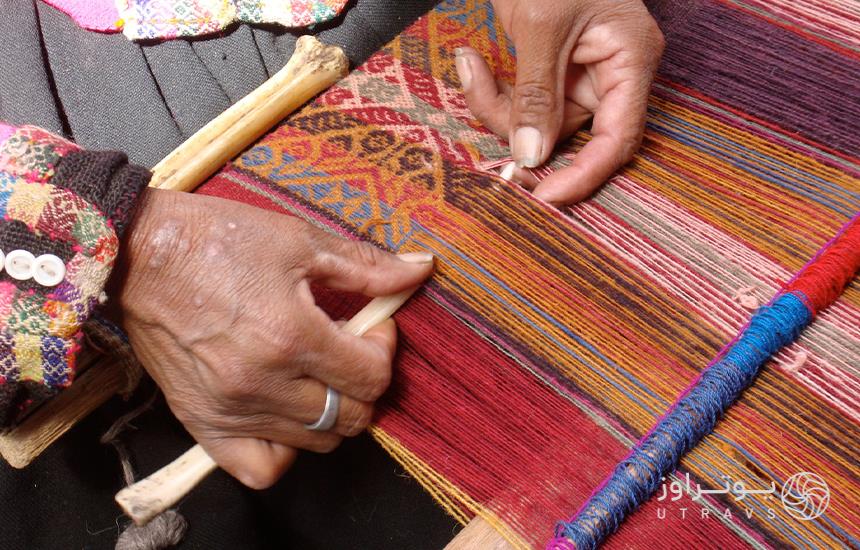In the dictionary of Dehkhoda, the kilim is defined as "a famous covering, woven from goat and sheep hair. Garment? The famous pashmin that is woven from sheep's wool. Carpet, this hand woven fabric has many uses and has been used in various fields. kilim mats, bags and kilim handicrafts are among the famous types of these kilim weaves. A kilim is a type of flat fabric without piles, which consists of taropods and does not have knots and long piles like a carpet. In the texture of the kilim , the thinner and softer the yarn is, the higher the quality of the woven product, therefore, in the kilim in which fluff (wool from the area under the neck or armpit of the sheep) or merino wool is used, the kilim has a much higher quality. The fame of hand-woven kilims, which Iran is famous for its texture and production, has covered the whole world and one of its origins is Iran.
kilim in Persian language and literature
The roots of this product are so deep that the kilim has been well used in literature and proverbs. For example, the well-known example of pulling your kilim out of the water, which is an allusion to being born and being saved, or the famous example of Pato, don't make your kilim longer than your rug, which refers to not interfering in something or something. Likewise, it is mentioned in poetry and literature, such as a poem by Saadi that says:
Dehl's song was not hidden
under the carpet and hidden love.
Or in another place, a poem by Ferdowsi that says:
To the feet inside the shoes and on the body of the kilim
to the load inside gems, gold and wire
Carpet in Iran
A kilim with motifs inspired by the culture and customs of each region and the creative mind of its weaver is woven from animal or vegetable fibers on vertical and horizontal looms, and it is the role, design, and fibers used in its texture that are the method of production and texture. determines As one of the oldest kilim of mankind, the kilim is simply woven. in such a way that it was passed through the weave one by one under and over each other. Since the fibers used in carpets are perishable, for this reason, as it should be, there is nothing left of these carpet products from ancient times to be able to refer to them. Carpet weaving in Iran dates back to more than 8000 years ago, and the proof of this claim is a hand-woven fabric found on the southeastern edge of the Caspian Sea. Also, a 6000-year-old hand-woven fabric found in Susa, which was evidence of carpet weaving in this region. Therefore, every corner of Iran is famous in the world for some kind of carpet weaving.
Carpet in ancient Egypt
Studies conducted in ancient Egyptian finds show the use of carpets around 3000 years ago. But due to the similarity of the texture of the early fabrics to the current texture of the kilim , it can be said that in the past, this type of rug was woven using thicker fibers.
Carpet weft taro
Usually, the thread of the carpet is made of cotton and wool, and sometimes silk thread, and its weft is made of wool, fluff and silk threads in a colored way. This product has different names in Persian language and literature. For example, Galim in Afghanistan, Gilim in Ukraine, Badas in the Caucasus, Liat in Syria and Lebanon, Chilim in Romania, as well as Kilim in Turkey, which is adapted from the same word in English, and is also a dialect in countries such as Poland, Hungary, and Saudi Arabia. It is different and it is mostly called kilim.
kilim pattern
Carpets were mostly woven with broken (geometric) patterns. These motifs mostly include rhombus, triangles, quadrangles, types of flowers, bushes, cashews, hexagons, types of domestic and predatory animals and many other motifs. There are various types of kilims , which can be called Glimcheh, Musnad, Khorjin, Verni, Javal, etc. mentioned. In our country, Iran, most rugs are woven in the provinces of Zanjan, Fars, Kurdistan, Mashhad, Ardabil, Gorgan, Kerman, Baluchistan, Azerbaijan, etc. Medium kilimsmusually have dimensions of one meter by two meters.
Carpet weaving method
Iranian rugs are produced in two ways, Sufi and Karbas, in standing or vertical dars, as well as in horizontal or ground state. A woven carpet includes the following components:
Chain weaving or braid weaving, white border or according to the taste of the weaver, shirazeh, simple border, border with text, tapestry, background and the motif itself. The carpet belongs to Kermanshah province. It is called Harsin carpet, which has a special reputation. Verni carpet is from Azerbaijan province and apparently this carpet is like a carpet, but it does not have piles that create a relief on this type of carpets, and today there is a machine-made version of it called carpet-carpet in the market. Two-sided carpet is a type of carpet from Ardabil province, which has the same shape on both sides of the carpet and has a variety of colors and patterns .
All kinds of rugs and carpet weaving in Iran
In Iran, carpets are woven in different ways, and in this part, a brief introduction about these methods is given. Many scientific articles have been written about these weaving methods and also the difference between these types of weaving at the university level, among which the following articles can be mentioned, such as: "The role of carpet weaving in rural development", "How to promote carpet weaving in the present era" and "The use of motifs". "Glime on modern clothes" and... which you can click on and read for more information. In order to get to know more about the types of Iranian rugs, they are introduced in this section so that the enthusiasts and enthusiasts of this fascinating and charming art can get to know more about it.
Types of Iranian carpet fabrics
1- Shirikipich kilim
"Shirikipich" kilim is one of the most prominent handwovens of rural and nomadic women of Sirjan city, which has made this region registered as a world kilim city in UNESCO and the World Handicrafts Council.
Features of Shiriki Bich carpet
The characteristic of Shiriki is that, unlike other types of kilim in which the threads create the product, the weft in this kilim weave does not play a role in the texture and only connects the threads to each other and makes the cream thread stronger with the threads. The word "Shiriki Pich" means a blanket for a horse, and probably in the past, this fabric was used only for this purpose. Another unique feature of Shiriki Beech is the subjectiveness of its design, which means that symbols and patterns are woven on the background without a previous map. Although in recent years, the younger weavers have distanced themselves from the mind of weaving and sometimes use maps for the main roles, but the older weavers are still loyal to what they have in mind and learned from their ancestors.
Shiriki Pich is the name given to it by the nomadic and rural weavers of Kerman. It looks like a carpet and it is woven with knots like a carpet, and unlike other types of kilim where the weft completes and shows its motifs, the weft only connects the threads to each other and is hidden behind the flesh (piles) and cannot be seen. Shiriki Beech motifs go beyond the geometric range and sometimes achieve balance and harmony from the combination of asymmetric motifs. The motif of the jake plant can be seen among the Shiriki Beech motifs, with two round flowers embedded in them, which are symmetrical to each other. The borders of these rugs are often chained and composed of a repeated geometric shape that is placed between two parallel lines. These margins are called wheel margins. The flower of the Glim text is Kashmiri, which fills the entire text with its repetition.
This beautifully patterned carpet, which is also used to produce carpet bags, carpet panels, and chair covers, has been a part of Iran's non-oil exports in the past years and has many customers in the markets of some European and Arab countries.
2- Verni carpet
It is not only one of the famous rugs of Ardabil and East Azarbaijan provinces, but also one of the most prominent sumacs in Iran. We know that sumac weaving is not unique to East Azarbaijan and Ardabil provinces and other types of it are woven in other provinces such as Kerman, Khuzestan, Fars and Khorasan. Varnish texture past Ardabil province is also common in East Azarbaijan province. Also, Varni weaves are woven in Turkey, Azerbaijan Republic and some regions and countries that used to be a part of Greater Iran and were separated from Iran during the Qajar period. Today, these countries are governed as an independent country and border with Ardabil and East Azerbaijan provinces. The villagers of the mentioned provinces are also involved in the weaving of this unique type of carpet due to their intermingling with these nomads. The process of producing this type of carpet was homemade in the beginning and also today, and the work tools are all prepared on site.
Design and pattern of Varni carpet
The entire varnished surface is covered with designs, patterns and micro-patterns that are subjective and taken from the geometric patterns of domestic and wild animals in the area. Therefore , characters such as deer, deer, wolf, herd dog, turkey, chicken, donkey, horse, cat, snake, eagle, sheep, goat, camel, lion, fox, jackal, peacock, local birds, etc. are among the characters that In a very beautiful and geometrical way, they are imprinted on the varnished texture . It seems that the nomads, in order to have a thicker base than a regular kilim , after the experiences they get from producing rugs, start producing verni, and in fact, "Verni" and "Shirki and Pitch" are the last places where the weavers stop producing this model. The product has progressed to rugs and carpets and has completed the evolution of rug weaving products and derivatives.
3- Rug
It is one of the Iranian carpets that are made in the villages around Sanandaj and Bijar using weaving methods and other raw materials. Its difference from ordinary rugs, as its name suggests, is that it is small and its motifs are more diverse than rugs, for example, the rugs of Kurdistan province mostly have simple shapes and the motifs are mostly filled with horizontal lines, while Kurdistan rugs often have diverse motifs.
One of the examples of the familiar and prominent name of this product model is Metkazin rug. Metkazin rug is one of the most original weaves of Mazandaran. The length of this rug varies from 100 to 150 cm and its width from 60 to 90 cm, and the weavers sew its pieces together from the length (side) to have a wider kilim . The warp of this product model is made of cotton yarn with a score of 20, twelve la, and the weft is made of wool, but in the past, both the warp and weft were made of woolen yarn.
4- Gilim Zillow
In most of the rural areas of Iran, this carpet model is woven with cotton thread and is mostly used as an underlay for summer. In most parts of Iran, zilo is woven with looms, but in the rural areas of Tehran, Kashan, Yazd and Saveh, it is produced by carpet weaving. It has a rough appearance and is not comparable to other types of this product model in terms of variety of colors and patterns, and it has less variety of colors.
Also, the origin of this carpet model can be considered Yazd. The name of the city, Yazd, comes to mind as an original souvenir of this city. Not long ago, this city was introduced as Zillow Global City. Zilo is one of the foundations of rural and agricultural areas of Yazd. This hand-woven fabric, which is mostly used in the tropical regions of Iran, for example, on the edge of the desert and in the south of the country, is the opposite of the rug. Because its material is vegetable and cotton and is suitable for farming areas, while the kilim is made from sheep wool, which is specific to livestock farming and cold regions.
5- Glim Plus or Pallas
These types of carpets are coarsely woven and the taro is made of cotton. This model is a one-sided kilim . In Plus, the so-called cheleh threads are not colored, which makes it different from Jajim. The weaver twists the uncolored wool threads into the head and the bottom (two horizontal wooden bars in the loom) and with the help of colored wefts made of wool and sometimes cut used fabrics, he makes patterns. Plus is much simpler and more basic than Jajim in terms of design and role.
The most famous Glim Plus is woven in the Turkmen region of the Sahara, which is also called Glim Palas. Turkmen blankets are famous and are of the type of carpet with woolen roots hanging on the back. In Yazd and other parts of Iran, especially among the nomads, this kilim is also woven. Because Glim Plus is woven with wool, it does not transfer moisture up from the ground or its surroundings. For this reason, it is used in carpeting the floor of nomadic tents or making the black of a tent, which is often used in wet and undrained lands, as well as in rural houses.
6- Musnad carpet
The origin of this type of carpet is Ardabil, and it is woven in the amber of Ardabil, and it can be said that the patterns of this carpet are adapted from Shiriki Pich, and usually the tranji is less visible in the middle, and the text flower, which is called Kashmiri, is filled throughout with repetition and other flowers. which are used in this weaving are: Khara, Garmai flower, Shah Abbasi flower, Jaffa flower and there is a border in this rug which is called Vakili border and the other one is called Charkhi border. One of its famous species is called Susani.
The motifs of this weaving, like all nomadic and iran handicrafts, are inspired by the beautiful and pristine nature of the villages and have a direct relationship with the environment, time and place conditions, culture, customs and traditions of the people of Nemin region and its surrounding villages.
Masand specifications
1. The motifs are intricate and due to the weaving method of this rug, the vertical lines are woven in steps.
2. The geometricity of the pictures, in such a way that curved and revolving lines are not seen in the Masnad.
3. There are no color restrictions in Musnad motifs, and the hand weaver is completely open in the variety of colors.
4. In the Masand text, the role of the subjects is usually separate and independent, and the lines are not related to each other.
5. The motifs and motifs of the Musnad materials are completely unique and distinguish the Musnad from other kilim .
6. The Musnad rug has symmetry in both width and length directions.
7. The motifs of the Musnad text are often surrounded by a row of borders.
8. Margins are composed of motifs and motifs connected and repeated.
9. Roles taken from animals and livestock, animal body parts, animal - crab - fish - sheep - owl - ram's head, etc. and also inspired by folklore (dresses, make-up, local dances) and body parts (cloud and bow ) and... and the roles taken from nature. bush - leaf - spike - water atmosphere - wave - flower spike - grassy bush - flower - Karabaghi.
7- Gilim Jol
Most of the cattle coverings that are woven from carpets are jel. On the front, the motifs are in the form of needlework, which is sewn on after the completion of the simple background texture. In this type of rug, the fabrics can be used on one side and have back and front. Gel is used to cover the sweaty ends.
8- Sajjad kilim
It is a type of rug that, as its name suggests, is used for performing prayers. This product model, which is designed and woven with a pattern of the altar, is light so that the worshiper can easily carry it and take it with him to pray anywhere. In the past, many people used to perform congregational prayers and Friday prayers in the mosques of the city. Due to the increase in the number of people, they used to pray in the courtyard or in a part of the mosque that was not carpeted. would fix In this model of the product, less complex motifs were used so that the senses of the worshiper would not be disturbed during the prayer, and for this reason, it is simple in terms of color and pattern, and has more of an altar and arch, and less geometric motifs are used in Um.
9- Chigh or Chigh kilim
Chigh, which is a wicker weave with a width of approximately 150 cm, and different patterns are created on it by colorful woolen threads, is one of the products of the nomadic areas of our country, which is used to protect the surroundings of black tents.
In most countries, it is used for the tent wall by dividing the tents. The rugs do not have a back and front, and they have the same beauty from both sides. The special motifs of qiq are the same as the traditional patterns of carpets, which have been changed according to the weaving method, due to the large unit of weaving in qiq, which is a reed.
Preparation of the scream kilim
To prepare chigh, the necessary straw is provided from around the rivers and then it is split and divided into four parts so that the width of each part is close to one centimeter. . The weavers, who are usually nomadic women, either remember the desired design for the preparation of the product and mentally divide it into different parts and weave each straw according to it, or they draw the design on paper and each straw on the map. They spin yarn, which is more true for women in the first category. These designs, which are completely original and traditional, are diverse and beautiful and include characters such as lion, deer, deer, etc. Each hand that is woven consists of 32 straws, which are woven into the bundles if necessary.
Chig can be considered one of the most important and valuable handicrafts of nomads, which is very beautiful apart from its very important use in the life of nomads, which is of course due to the capable and artistic hands of nomad women through its patterns and coloring. This texture is used as a fence around the black tent or (sheep fence) and of course any place where they want to divide that space in some way. They also use the qiq rug to protect small lambs in the cold season and place it in the corner or back of the tent and cover its floor with straw to protect the lambs and goats from disease.
Main ingredients
The main materials of most of these handicrafts are goat hair, sheep (in some cases camel) wool. Of course, vegetable fibers are also used in some cases, such as cotton, which plays a role in many purchases of Iranian handicrafts . As it is known, handicrafts originate from livestock and agricultural products. They use reeds (plant fibers that are provided from around the rivers) and goat hair (sometimes wool and sometimes colored yarns) to make chig. Although the tools used are simple and basic, for example scythe, knife, file, lid, scissors and needle... but the main element that makes this "art-craft" emerge is the skill and taste of its weavers.
10- Mattress
One of Iran's decorative-use handicrafts is called "mafaresh". It is a hand-woven rug with a rectangular shape and a box-shaped door, which is used to transport quilts and mattresses or household items during nomadic migrations. Its motifs are sometimes prominent and additional. Mofarsh's carvings and paintings are attractive and happy, and its production is mostly in Ardabil, among tribes and tribes including Kerman tribes and Shahson tribe. How to maintain it, willow protection, continuous humidity, heat and fire, radiation? It is directly and continuously exposed to the sun, chemical bleaches and sharp objects and can be washed with lukewarm water and soap and ordinary non-acidic detergents.
11-Other carpet fabrics
There are other rugs, such as the Kashe or Kuche kilim , which is originally hand-woven by the Turkmens, as well as the Chente kilim , which is similar to Khorjin and is woven in Fars, and the proverb, "We have nothing in the Chente", refers to the same model of product, which is also thrown on the four legs. They used to pour provisions and necessities inside it. Similarly, another model of rugs is the joval, which is used to pour food or store it in some ways and it looks like a bag. Put your unreasonable expectations from your people in their place and if you see their faults as big and numerous, be fair and look at your own faults as well.
- ۰ ۰
- ۰ نظر
 صنایع دستی حصیری
صنایع دستی حصیری صنایع دستی استانبول
صنایع دستی استانبول سوغات و صنایع دستی خوی
سوغات و صنایع دستی خوی خرید صنایع دستی برای سال جدید
خرید صنایع دستی برای سال جدید 6 نکته خیلی مهم برای هدیه دادن
6 نکته خیلی مهم برای هدیه دادن 13 مورد از بهترین صنایع دستی تبریز
13 مورد از بهترین صنایع دستی تبریز.jpg) صنايع دستي کاشان
صنايع دستي کاشان A few tips when buying a men's shoulder bag
A few tips when buying a men's shoulder bag دومین مطلب آزمایشی من
دومین مطلب آزمایشی من اولین مطالب آزمایشی من
اولین مطالب آزمایشی من